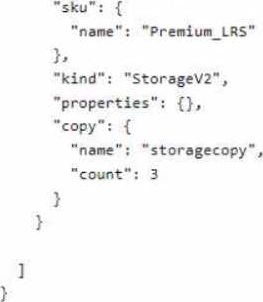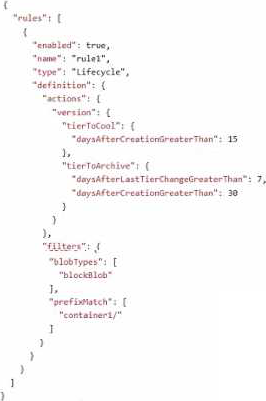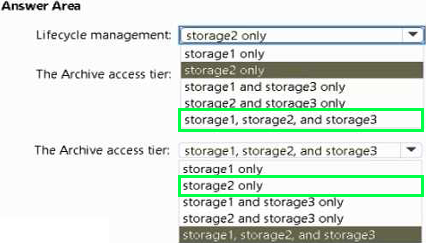Practice Free AZ-104 Exam Online Questions
HOTSPOT
You have an Azure subscription that contains a virtual network named VNET in the East Us 2 region. A network interface named VM1-NI is connected to VNET1.
You successfully deploy the following Azure Resource Manager template.



Explanation:
"A resource can only be created in a virtual network that exists in the same region and subscription as the resource." https://learn.microsoft.com/en-us/azure/virtual-network/virtual-network-vnet-plan-design-arm#regions
HOTSPOT
You have an Azure subscription.
You create the following file named Deploy.json.

You connect to the subscription and run the following commands.
![]()
For each of the following statements, select Yes if the statement is true. Otherwise, select No. NOTE: Each correct selection is worth one point.


HOTSPOT
You have an Azure Storage account named storage1 that contains two containers named container 1
and container2. Blob versioning is enabled for both containers.
You periodically take blob snapshots of critical blobs.
You create the following lifecycle management policy:

For each of the following statements, select Yes If the statement is true. Otherwise, select No. NOTE: Each correct selection is worth one point.


Explanation:
Based on the lifecycle management policy you created and the information from the web search results, here are the answers to your statements:
A blob snapshot automatically moves to the Cool access tier after 15 days. = Yes
A blob version in container2 automatically moves to the Archive access tier after 30 days. = No
A rehydrated version automatically moves to the Archive access tier after 30 days. = No
The lifecycle management policy you created has two rules: one for container1 and one for container2. The rule for container1 has an action that moves blob snapshots to the Cool access tier if they are older than 15 days. Therefore, a blob snapshot in container1 will automatically move to the Cool access tier after 15 days, regardless of the access tier of the base blob.
The rule for container2 has an action that moves blob versions to the Archive access tier if they are older than 30 days and have a prefix match of “archive/”. Therefore, a blob version in container2 will only automatically move to the Archive access tier after 30 days if its name starts with “archive/”. Otherwise, it will remain in its current access tier.
A rehydrated version is a blob version that was previously in the Archive access tier and was restored to an online access tier (Hot or Cool) by using the rehydrate priority option1. A rehydrated version does not automatically move to the Archive access tier after 30 days, unless there is a lifecycle management policy rule that explicitly specifies this action. In your case, neither of the rules applies to rehydrated versions, so they will stay in their online access tiers until you manually change them or delete them.
You have the Azure virtual machines shown in the following table.

You have a Recovery Services vault that protects VM1 and VM2. You need to protect VM3 and VM4 by using Recovery Services.
What should you do first?
- A . Create a new Recovery Services vault.
- B . Configure the extensions for VM3 and VM4.
- C . Create a storage account.
- D . Create a new backup policy.
HOTSPOT
You have an Azure subscription that contains the virtual networks shown in the following table.

You have the virtual machines shown in the following table.

You have the virtual network interfaces shown in the following table.

Server1 is a DNS server that contains the resources shown in the following table.

You have an Azure private DNS zone named contoso.com that has a virtual network link to VNET2 and the records shown in the following table.

For each of the following statements, select Yes if the statement is true. Otherwise, select No. NOTE: Each correct selection is worth one point.


You have a Standard Azure App Service plan named Plan1.
You need to ensure that Plan1 will scale automatically when the CPU usage of the web app exceeds 80 percent.
What should you select for Plan1?
- A . Automatic in the Scale out method settings
- B . Rules Based m the Scale out method settings
- C . Premium P1 in the Scale up (App Service plan) settings
- D . Standard S1 in the Scale up (App Service plan) settings
- E . Manual in the Scale out method settings
You have a Standard Azure App Service plan named Plan1.
You need to ensure that Plan1 will scale automatically when the CPU usage of the web app exceeds 80 percent.
What should you select for Plan1?
- A . Automatic in the Scale out method settings
- B . Rules Based m the Scale out method settings
- C . Premium P1 in the Scale up (App Service plan) settings
- D . Standard S1 in the Scale up (App Service plan) settings
- E . Manual in the Scale out method settings
HOTSPOT
You have an Azure virtual machine named VM1 that connects to a virtual network named VNet1.
VM1 has the following configurations:
✑ Subnet: 10.0.0.0/24
✑ Availability set: AVSet
✑ Network security group (NSG): None
✑ Private IP address: 10.0.0.4 (dynamic)
✑ Public IP address: 40.90.219.6 (dynamic)
You deploy a standard, Internet-facing load balancer named slb1.
You need to configure slb1 to allow connectivity to VM1.
Which changes should you apply to VM1 as you configure slb1? To answer, select the appropriate options in the answer area. NOTE: Each correct selection is worth one point.
in the answer area. NOTE: Each correct selection is worth one point.


Explanation:
Box 1: Remove the public IP address from VM1
If the Public IP on VM1 is set to Dynamic, that means it is a Public IP with Basic SKU because Public IPs with Standard SKU have Static assignments by default, that cannot be changed. We cannot associate Basic SKUs IPs with Standard SKUs LBs. One cannot create a backend SLB pool if the VM to be associated has a Public IP. For Private IP it doesn’t matter weather it is dynamic or static, still we can add the such VM into the SLB backend pool.
Box 2: Create and configure an NSG
Standard Load Balancer is built on the zero trust network security model at its core. Standard Load Balancer secure by default and is part of your virtual network. The virtual network is a private and isolated network. This means Standard Load Balancers and Standard Public IP addresses are closed to inbound flows unless opened by Network Security Groups. NSGs are used to explicitly permit allowed traffic. If you do not have an NSG on a subnet or NIC of your virtual machine resource, traffic is not allowed to reach this resource. To learn more about NSGs and how to apply them for your scenario, see Network Security Groups. Basic Load Balancer is open to the internet by default.
Reference:
https://docs.microsoft.com/en-us/azure/load-balancer/quickstart-load-balancer-standard-public-portal
https://docs.microsoft.com/en-us/azure/load-balancer/load-balancer-overview
HOTSPOT
You have an Azure subscription that contains the storage accounts shown in the following table.

You need to identify which storage accounts support lifecycle management, and which storage accounts support moving data to the Archive access tier.
What should you identify for each requirement? To answer, select the appropriate options in the answer area. NOTE: Each correct answer is worth one point.


Explanation:
1) storage1, storage2, storage3
"Lifecycle management policies are supported for block blobs and append blobs in general-purpose v2, premium block blob, and Blob Storage accounts." https://learn.microsoft.com/en-us/azure/storage/blobs/lifecycle-management-overview
2) storage2
"The archive tier isn’t supported for ZRS, GZRS, or RA-GZRS accounts." https://learn.microsoft.com/en-us/azure/storage/blobs/access-tiers-overview#archive-access-tier
HOTSPOT
You have an Azure AD tenant.
You need to create a Microsoft 365 group that contains only members of a marketing department in France.
How should you complete the dynamic membership rule? To answer, select the appropriate options in the answer area. NOTE: Each correct answer is worth one point.


